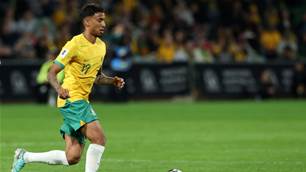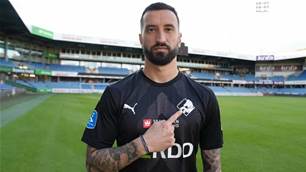If Harry Kewell and the Socceroos are to make it to the 2010 World Cup in South Africa, they should follow our “Five Step Guide To World Cup Qualification”
Page 3 of 3 | Single page
STEP FIVE
Deal With The Threat Of Japan
Though Australia doesn’t necessarily have to overcome Japan to qualify for South Africa, the Japanese side still poses our most significant hurdle. It is relieving to hear then that not all is rosy for the Blue Samurai.
After former coach Ivica Osim suffered a stroke late last year, Takeshi Okada has taken the reigns of Japan’s national side. Okada has already had a stint in charge in the late 1990s, when his side recorded three losses to bow out early at its first World Cup finals in France.
After some trouble in the previous stage, together with his former record as national team boss and continued criticism over his style, Okada is currently an unpopular figure in Japan.
SBS football reporter Scott McIntyre has spent much of the last decade living and working in Japan. As an FC Tokyo fan, he is a close follower of the Japanese game.
“Let’s not forget that Okada’s not first choice to be here. Osim came in and was very vocal about the fact the Asian Cup was preparation for the World Cup qualifiers.
“Is he the right man for the job? Probably not,” he says. “If in the first say, two games, the results aren’t there, I wouldn’t be surprised at all to see a big name foreign coach come in by the time Australia comes to Japan.”
On the pitch, the Japan squad is far from invincible. The biggest hole is up front.
“The country hasn’t produced a top rate striker since Kazu,” McIntyre believes. “The J.League is great for the production of young Japanese goalkeepers, defenders and midfielders, but what the emphasis on foreign strikers [at J.League clubs] has done is that it’s killed any development process for Japanese strikers.”
In midfield, however, Japan’s quality is sure test to Australia, despite the Socceroos boasting a world-class midfield of their own. Shunsuke Nakamura is the best-known Japanese player, but McIntyre puts this status down to flag-waving female fans making him the Japanese Beckham. Instead he names Daisuke Matsui and Keita Suzuki as the team’s most important players.
Matsui has spent the last four years in France at first Le Mans and now St Etienne, while Suzuki has long been a fixture of the powerful Urawa side.
However, it is Suzuki’s club team-mate Marcus Tulio Tanaka who could prove to be Japan’s trump card. Brazilian born with Italian and Japanese heritage, Tanaka is the only Japanese player in the J.League’s top ten goalscorers this season, and looks certain to be the centerpiece of a mean Japanese defence.
“There’s a perception that still exists that defensively Asian players and especially Japanese players are somehow small and slightly built. Now they’ve got Tanaka and Yuji Nakazawa who’s an absolutely beast. These guys are bigger than anything Australia can put on the park.”
FourFourTwo Says
There’s no middle ground with Japan. Its threat in the group will either be minimal – we pick up enough points that our head-to-head with them is irrelevant – or critical – a winner goes to the World Cup in the last game of qualifying at the MCG on June 17.
This article appeared in the October edition of Australian FourFourTwo. To subscribe, click here
Deal With The Threat Of Japan
Though Australia doesn’t necessarily have to overcome Japan to qualify for South Africa, the Japanese side still poses our most significant hurdle. It is relieving to hear then that not all is rosy for the Blue Samurai.
After former coach Ivica Osim suffered a stroke late last year, Takeshi Okada has taken the reigns of Japan’s national side. Okada has already had a stint in charge in the late 1990s, when his side recorded three losses to bow out early at its first World Cup finals in France.
After some trouble in the previous stage, together with his former record as national team boss and continued criticism over his style, Okada is currently an unpopular figure in Japan.
SBS football reporter Scott McIntyre has spent much of the last decade living and working in Japan. As an FC Tokyo fan, he is a close follower of the Japanese game.
“Let’s not forget that Okada’s not first choice to be here. Osim came in and was very vocal about the fact the Asian Cup was preparation for the World Cup qualifiers.
“Is he the right man for the job? Probably not,” he says. “If in the first say, two games, the results aren’t there, I wouldn’t be surprised at all to see a big name foreign coach come in by the time Australia comes to Japan.”
On the pitch, the Japan squad is far from invincible. The biggest hole is up front.
“The country hasn’t produced a top rate striker since Kazu,” McIntyre believes. “The J.League is great for the production of young Japanese goalkeepers, defenders and midfielders, but what the emphasis on foreign strikers [at J.League clubs] has done is that it’s killed any development process for Japanese strikers.”
In midfield, however, Japan’s quality is sure test to Australia, despite the Socceroos boasting a world-class midfield of their own. Shunsuke Nakamura is the best-known Japanese player, but McIntyre puts this status down to flag-waving female fans making him the Japanese Beckham. Instead he names Daisuke Matsui and Keita Suzuki as the team’s most important players.
Matsui has spent the last four years in France at first Le Mans and now St Etienne, while Suzuki has long been a fixture of the powerful Urawa side.
However, it is Suzuki’s club team-mate Marcus Tulio Tanaka who could prove to be Japan’s trump card. Brazilian born with Italian and Japanese heritage, Tanaka is the only Japanese player in the J.League’s top ten goalscorers this season, and looks certain to be the centerpiece of a mean Japanese defence.
“There’s a perception that still exists that defensively Asian players and especially Japanese players are somehow small and slightly built. Now they’ve got Tanaka and Yuji Nakazawa who’s an absolutely beast. These guys are bigger than anything Australia can put on the park.”
FourFourTwo Says
There’s no middle ground with Japan. Its threat in the group will either be minimal – we pick up enough points that our head-to-head with them is irrelevant – or critical – a winner goes to the World Cup in the last game of qualifying at the MCG on June 17.
This article appeared in the October edition of Australian FourFourTwo. To subscribe, click here
Related Articles

Socceroos midfielder embraces move to England

Cardiff City snap up sought-after Socceroos starlet













